NURS3004 Assignment 3: Ethical Dilemma Reflection in Nursing Practice
VerifiedAdded on 2022/10/12
|10
|2600
|84
Report
AI Summary
This report reflects on an ethical dilemma faced by a nursing student during a practical placement involving a dementia patient refusing medication. The student used the MORAL model of ethical decision-making and the ICN Code of Ethics for Nurses to analyze the situation. The report outlines the dilemma, explores options, reviews criteria, affirms the student's position, and offers a look back at the incident. The student discusses the challenges of balancing patient autonomy with the need for medication, the importance of respecting patient rights, and the pressures faced by nurses in providing care. The report highlights the ethical considerations of administering medication, particularly when a patient is resistant, and the need for alternative approaches and consultation. The student ultimately reflects on the decision made, acknowledging the complexities of ethical practice in nursing.
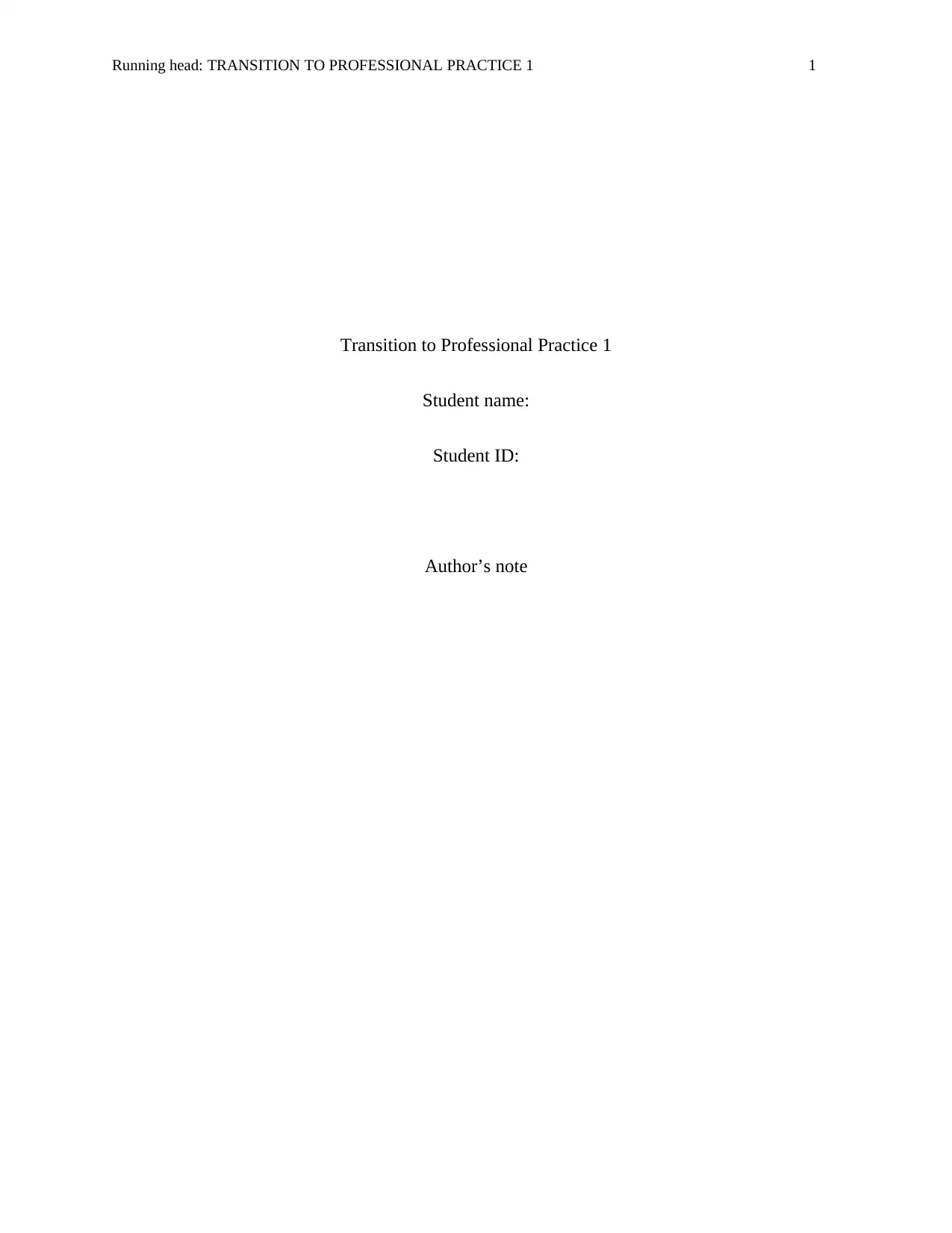
Running head: TRANSITION TO PROFESSIONAL PRACTICE 1 1
Transition to Professional Practice 1
Student name:
Student ID:
Author’s note
Transition to Professional Practice 1
Student name:
Student ID:
Author’s note
Paraphrase This Document
Need a fresh take? Get an instant paraphrase of this document with our AI Paraphraser
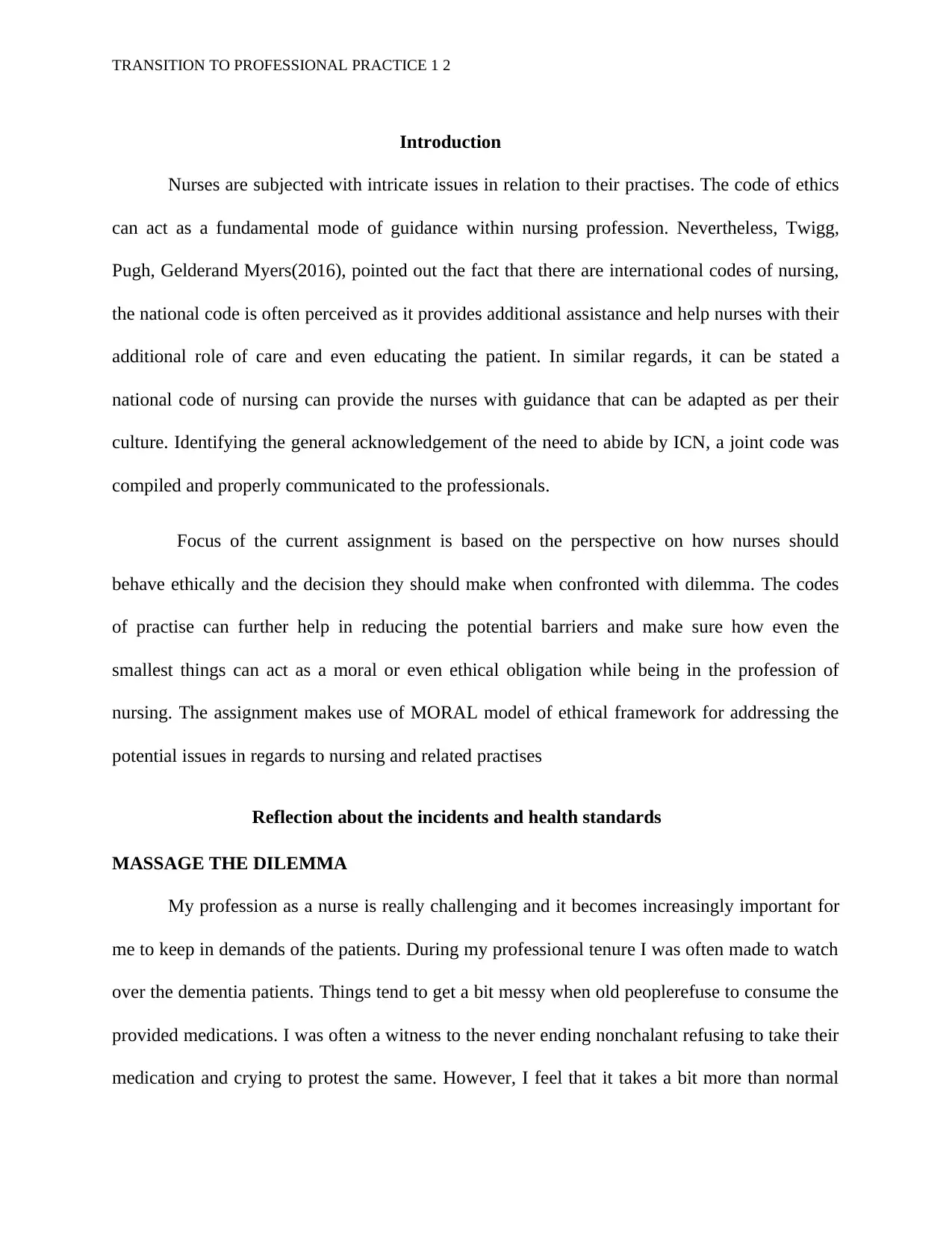
TRANSITION TO PROFESSIONAL PRACTICE 1 2
Introduction
Nurses are subjected with intricate issues in relation to their practises. The code of ethics
can act as a fundamental mode of guidance within nursing profession. Nevertheless, Twigg,
Pugh, Gelderand Myers(2016), pointed out the fact that there are international codes of nursing,
the national code is often perceived as it provides additional assistance and help nurses with their
additional role of care and even educating the patient. In similar regards, it can be stated a
national code of nursing can provide the nurses with guidance that can be adapted as per their
culture. Identifying the general acknowledgement of the need to abide by ICN, a joint code was
compiled and properly communicated to the professionals.
Focus of the current assignment is based on the perspective on how nurses should
behave ethically and the decision they should make when confronted with dilemma. The codes
of practise can further help in reducing the potential barriers and make sure how even the
smallest things can act as a moral or even ethical obligation while being in the profession of
nursing. The assignment makes use of MORAL model of ethical framework for addressing the
potential issues in regards to nursing and related practises
Reflection about the incidents and health standards
MASSAGE THE DILEMMA
My profession as a nurse is really challenging and it becomes increasingly important for
me to keep in demands of the patients. During my professional tenure I was often made to watch
over the dementia patients. Things tend to get a bit messy when old peoplerefuse to consume the
provided medications. I was often a witness to the never ending nonchalant refusing to take their
medication and crying to protest the same. However, I feel that it takes a bit more than normal
Introduction
Nurses are subjected with intricate issues in relation to their practises. The code of ethics
can act as a fundamental mode of guidance within nursing profession. Nevertheless, Twigg,
Pugh, Gelderand Myers(2016), pointed out the fact that there are international codes of nursing,
the national code is often perceived as it provides additional assistance and help nurses with their
additional role of care and even educating the patient. In similar regards, it can be stated a
national code of nursing can provide the nurses with guidance that can be adapted as per their
culture. Identifying the general acknowledgement of the need to abide by ICN, a joint code was
compiled and properly communicated to the professionals.
Focus of the current assignment is based on the perspective on how nurses should
behave ethically and the decision they should make when confronted with dilemma. The codes
of practise can further help in reducing the potential barriers and make sure how even the
smallest things can act as a moral or even ethical obligation while being in the profession of
nursing. The assignment makes use of MORAL model of ethical framework for addressing the
potential issues in regards to nursing and related practises
Reflection about the incidents and health standards
MASSAGE THE DILEMMA
My profession as a nurse is really challenging and it becomes increasingly important for
me to keep in demands of the patients. During my professional tenure I was often made to watch
over the dementia patients. Things tend to get a bit messy when old peoplerefuse to consume the
provided medications. I was often a witness to the never ending nonchalant refusing to take their
medication and crying to protest the same. However, I feel that it takes a bit more than normal

TRANSITION TO PROFESSIONAL PRACTICE 1 3
patience to cope with the never ending wishes of older adults. One such incident that I witnessed
was an adult refusing to take his medication as he complained that medicine may hurt him as he
found it difficult to swallow. I was faced with confusion on how to provide the medication to the
patient as he was reluctant in consuming medication. I thought of understanding the perspective
of the patient and even thought about the potential problems faced by the individual. My
colleagues advised me to coax the medication; as we have other tasks to attend and sticking with
one patient can neglect the care provision for another. However, Martin, Jones & Wolfe (2017)
pointed the fact forcing administration of medication can do more harm than good; the
medication can get have adverse impactand create adverse conditions. I felt that forcing the
patient to take the medicine is not right. It is for the same reason I mixed the medication with ice-
cream for making it more palatable.
Based on the ICN code of ethics for nurses, it is important to understand the fact that
nursing in addition to care is inclusive of respecting human rights (icn.ch, 2018).The right to
refuse medication is justified on the part of patient. In similar regards, it would be fair enough to
state that right to be treated with dignity is part of my professional ethics (Jones et al. 2018).
Thus, I did not violate the rights of forcing the medication as it is against the ethics. In similar
regards, I did abide by the ethics of ICN code of practise from provision 1 for treating patients
with dignity
OUTLINE THE OPTIONS
There remains no doubt that hiding the medicine in tasty food is an age old tradition for
convincing the older patients. Initially, I was highly confused as it was my first time with anold
patient refusing to take medications. I previously worked with older patients with proper mental
health condition and I did feel the same situation with them. However, in the case of former I
patience to cope with the never ending wishes of older adults. One such incident that I witnessed
was an adult refusing to take his medication as he complained that medicine may hurt him as he
found it difficult to swallow. I was faced with confusion on how to provide the medication to the
patient as he was reluctant in consuming medication. I thought of understanding the perspective
of the patient and even thought about the potential problems faced by the individual. My
colleagues advised me to coax the medication; as we have other tasks to attend and sticking with
one patient can neglect the care provision for another. However, Martin, Jones & Wolfe (2017)
pointed the fact forcing administration of medication can do more harm than good; the
medication can get have adverse impactand create adverse conditions. I felt that forcing the
patient to take the medicine is not right. It is for the same reason I mixed the medication with ice-
cream for making it more palatable.
Based on the ICN code of ethics for nurses, it is important to understand the fact that
nursing in addition to care is inclusive of respecting human rights (icn.ch, 2018).The right to
refuse medication is justified on the part of patient. In similar regards, it would be fair enough to
state that right to be treated with dignity is part of my professional ethics (Jones et al. 2018).
Thus, I did not violate the rights of forcing the medication as it is against the ethics. In similar
regards, I did abide by the ethics of ICN code of practise from provision 1 for treating patients
with dignity
OUTLINE THE OPTIONS
There remains no doubt that hiding the medicine in tasty food is an age old tradition for
convincing the older patients. Initially, I was highly confused as it was my first time with anold
patient refusing to take medications. I previously worked with older patients with proper mental
health condition and I did feel the same situation with them. However, in the case of former I
⊘ This is a preview!⊘
Do you want full access?
Subscribe today to unlock all pages.

Trusted by 1+ million students worldwide
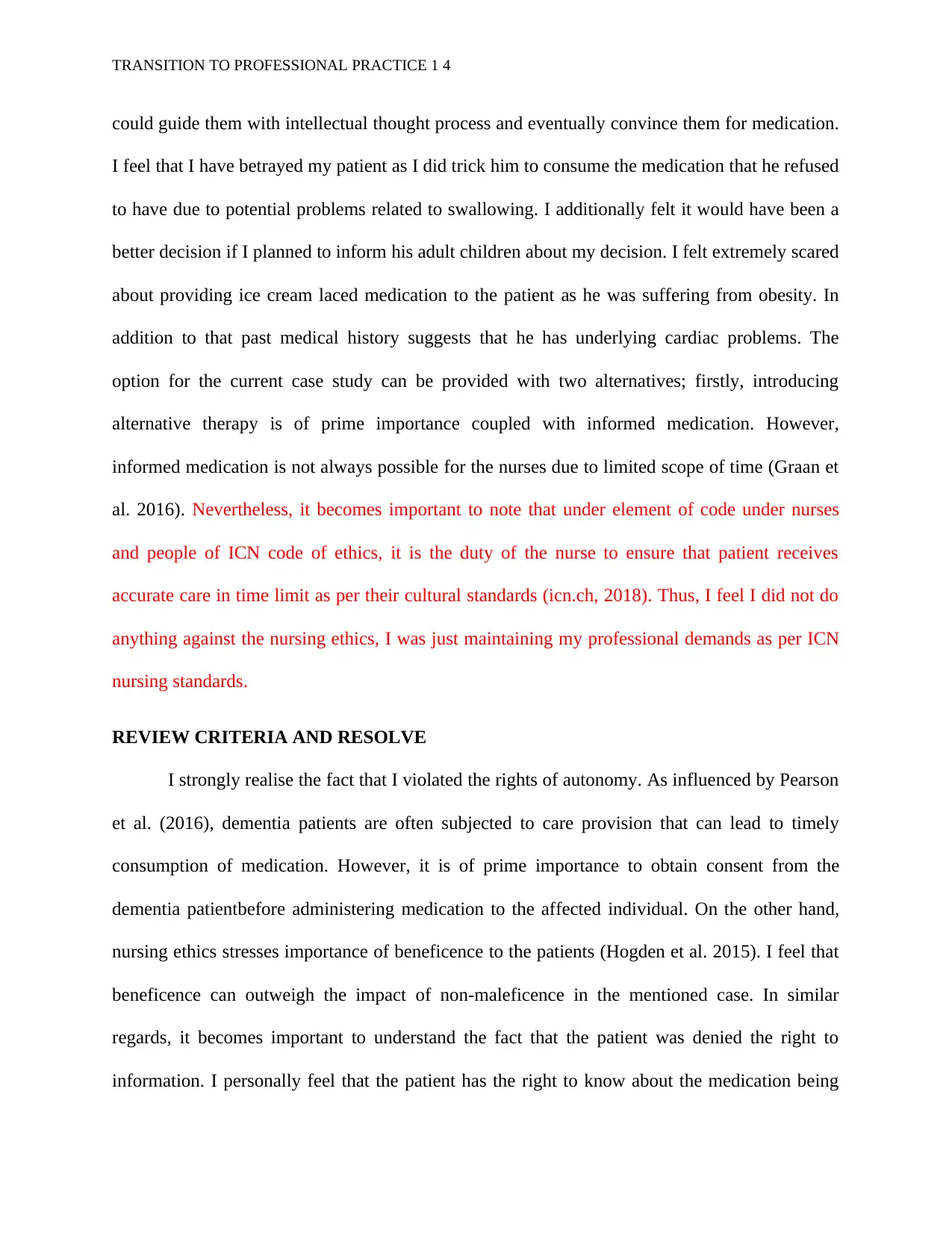
TRANSITION TO PROFESSIONAL PRACTICE 1 4
could guide them with intellectual thought process and eventually convince them for medication.
I feel that I have betrayed my patient as I did trick him to consume the medication that he refused
to have due to potential problems related to swallowing. I additionally felt it would have been a
better decision if I planned to inform his adult children about my decision. I felt extremely scared
about providing ice cream laced medication to the patient as he was suffering from obesity. In
addition to that past medical history suggests that he has underlying cardiac problems. The
option for the current case study can be provided with two alternatives; firstly, introducing
alternative therapy is of prime importance coupled with informed medication. However,
informed medication is not always possible for the nurses due to limited scope of time (Graan et
al. 2016). Nevertheless, it becomes important to note that under element of code under nurses
and people of ICN code of ethics, it is the duty of the nurse to ensure that patient receives
accurate care in time limit as per their cultural standards (icn.ch, 2018). Thus, I feel I did not do
anything against the nursing ethics, I was just maintaining my professional demands as per ICN
nursing standards.
REVIEW CRITERIA AND RESOLVE
I strongly realise the fact that I violated the rights of autonomy. As influenced by Pearson
et al. (2016), dementia patients are often subjected to care provision that can lead to timely
consumption of medication. However, it is of prime importance to obtain consent from the
dementia patientbefore administering medication to the affected individual. On the other hand,
nursing ethics stresses importance of beneficence to the patients (Hogden et al. 2015). I feel that
beneficence can outweigh the impact of non-maleficence in the mentioned case. In similar
regards, it becomes important to understand the fact that the patient was denied the right to
information. I personally feel that the patient has the right to know about the medication being
could guide them with intellectual thought process and eventually convince them for medication.
I feel that I have betrayed my patient as I did trick him to consume the medication that he refused
to have due to potential problems related to swallowing. I additionally felt it would have been a
better decision if I planned to inform his adult children about my decision. I felt extremely scared
about providing ice cream laced medication to the patient as he was suffering from obesity. In
addition to that past medical history suggests that he has underlying cardiac problems. The
option for the current case study can be provided with two alternatives; firstly, introducing
alternative therapy is of prime importance coupled with informed medication. However,
informed medication is not always possible for the nurses due to limited scope of time (Graan et
al. 2016). Nevertheless, it becomes important to note that under element of code under nurses
and people of ICN code of ethics, it is the duty of the nurse to ensure that patient receives
accurate care in time limit as per their cultural standards (icn.ch, 2018). Thus, I feel I did not do
anything against the nursing ethics, I was just maintaining my professional demands as per ICN
nursing standards.
REVIEW CRITERIA AND RESOLVE
I strongly realise the fact that I violated the rights of autonomy. As influenced by Pearson
et al. (2016), dementia patients are often subjected to care provision that can lead to timely
consumption of medication. However, it is of prime importance to obtain consent from the
dementia patientbefore administering medication to the affected individual. On the other hand,
nursing ethics stresses importance of beneficence to the patients (Hogden et al. 2015). I feel that
beneficence can outweigh the impact of non-maleficence in the mentioned case. In similar
regards, it becomes important to understand the fact that the patient was denied the right to
information. I personally feel that the patient has the right to know about the medication being
Paraphrase This Document
Need a fresh take? Get an instant paraphrase of this document with our AI Paraphraser
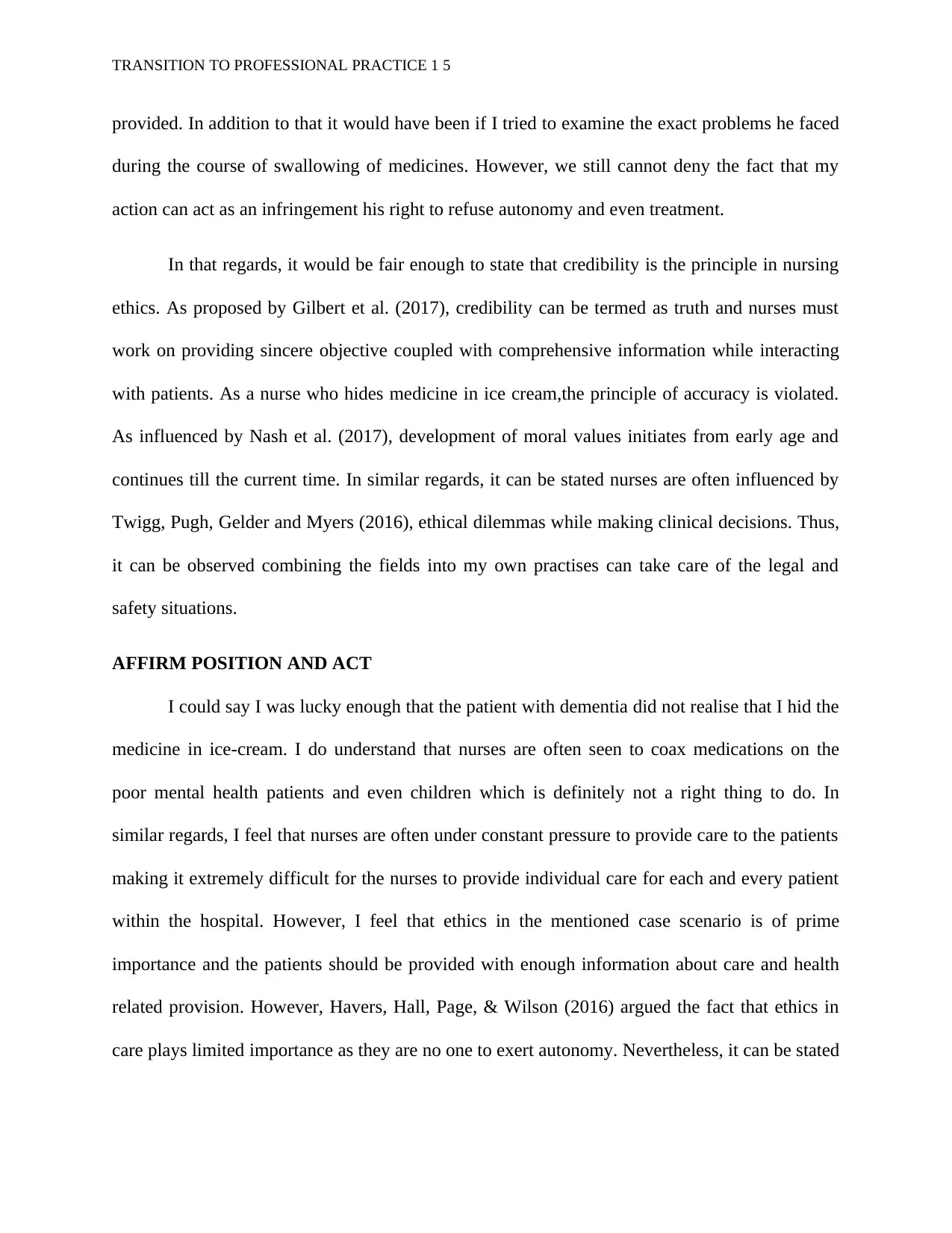
TRANSITION TO PROFESSIONAL PRACTICE 1 5
provided. In addition to that it would have been if I tried to examine the exact problems he faced
during the course of swallowing of medicines. However, we still cannot deny the fact that my
action can act as an infringement his right to refuse autonomy and even treatment.
In that regards, it would be fair enough to state that credibility is the principle in nursing
ethics. As proposed by Gilbert et al. (2017), credibility can be termed as truth and nurses must
work on providing sincere objective coupled with comprehensive information while interacting
with patients. As a nurse who hides medicine in ice cream,the principle of accuracy is violated.
As influenced by Nash et al. (2017), development of moral values initiates from early age and
continues till the current time. In similar regards, it can be stated nurses are often influenced by
Twigg, Pugh, Gelder and Myers (2016), ethical dilemmas while making clinical decisions. Thus,
it can be observed combining the fields into my own practises can take care of the legal and
safety situations.
AFFIRM POSITION AND ACT
I could say I was lucky enough that the patient with dementia did not realise that I hid the
medicine in ice-cream. I do understand that nurses are often seen to coax medications on the
poor mental health patients and even children which is definitely not a right thing to do. In
similar regards, I feel that nurses are often under constant pressure to provide care to the patients
making it extremely difficult for the nurses to provide individual care for each and every patient
within the hospital. However, I feel that ethics in the mentioned case scenario is of prime
importance and the patients should be provided with enough information about care and health
related provision. However, Havers, Hall, Page, & Wilson (2016) argued the fact that ethics in
care plays limited importance as they are no one to exert autonomy. Nevertheless, it can be stated
provided. In addition to that it would have been if I tried to examine the exact problems he faced
during the course of swallowing of medicines. However, we still cannot deny the fact that my
action can act as an infringement his right to refuse autonomy and even treatment.
In that regards, it would be fair enough to state that credibility is the principle in nursing
ethics. As proposed by Gilbert et al. (2017), credibility can be termed as truth and nurses must
work on providing sincere objective coupled with comprehensive information while interacting
with patients. As a nurse who hides medicine in ice cream,the principle of accuracy is violated.
As influenced by Nash et al. (2017), development of moral values initiates from early age and
continues till the current time. In similar regards, it can be stated nurses are often influenced by
Twigg, Pugh, Gelder and Myers (2016), ethical dilemmas while making clinical decisions. Thus,
it can be observed combining the fields into my own practises can take care of the legal and
safety situations.
AFFIRM POSITION AND ACT
I could say I was lucky enough that the patient with dementia did not realise that I hid the
medicine in ice-cream. I do understand that nurses are often seen to coax medications on the
poor mental health patients and even children which is definitely not a right thing to do. In
similar regards, I feel that nurses are often under constant pressure to provide care to the patients
making it extremely difficult for the nurses to provide individual care for each and every patient
within the hospital. However, I feel that ethics in the mentioned case scenario is of prime
importance and the patients should be provided with enough information about care and health
related provision. However, Havers, Hall, Page, & Wilson (2016) argued the fact that ethics in
care plays limited importance as they are no one to exert autonomy. Nevertheless, it can be stated
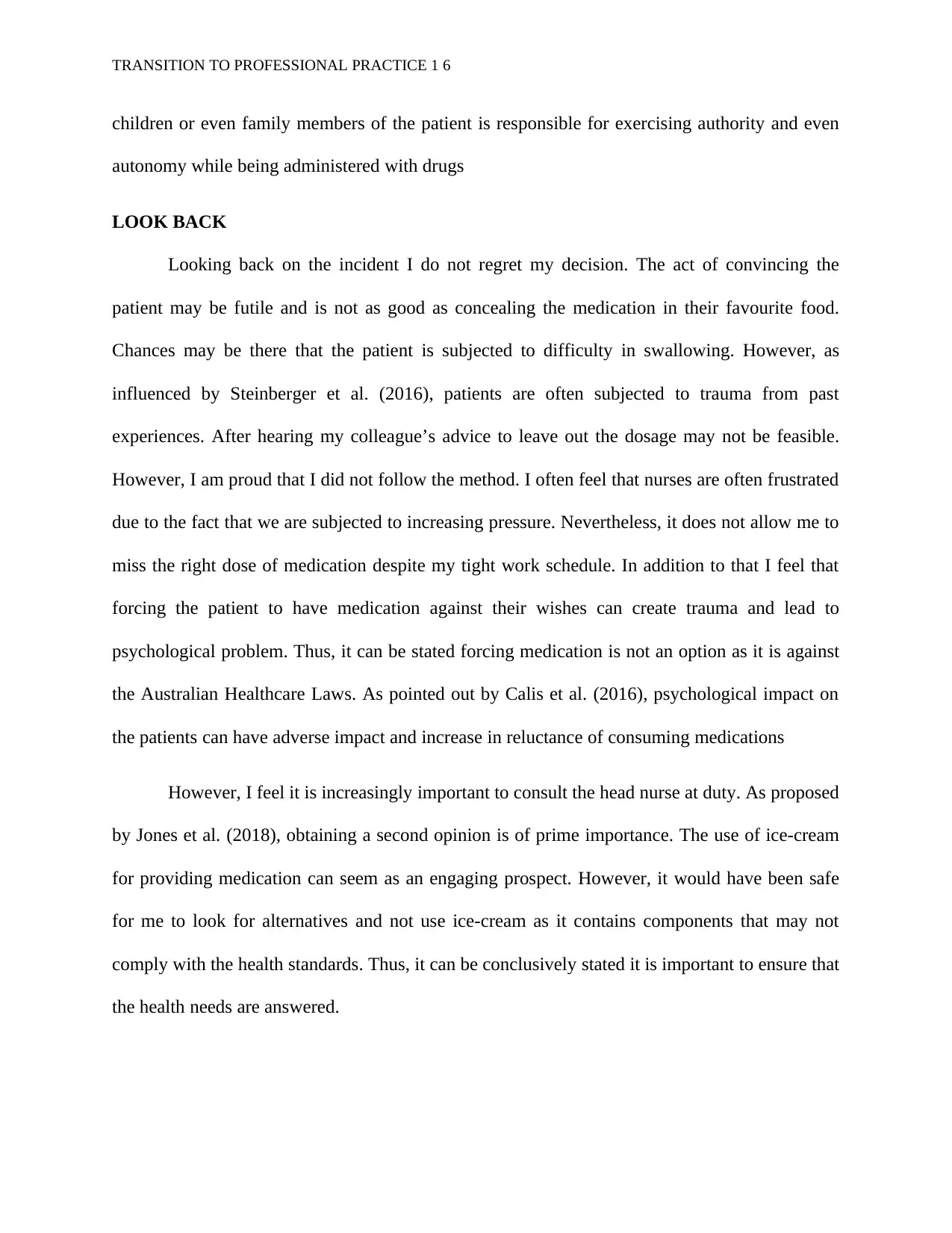
TRANSITION TO PROFESSIONAL PRACTICE 1 6
children or even family members of the patient is responsible for exercising authority and even
autonomy while being administered with drugs
LOOK BACK
Looking back on the incident I do not regret my decision. The act of convincing the
patient may be futile and is not as good as concealing the medication in their favourite food.
Chances may be there that the patient is subjected to difficulty in swallowing. However, as
influenced by Steinberger et al. (2016), patients are often subjected to trauma from past
experiences. After hearing my colleague’s advice to leave out the dosage may not be feasible.
However, I am proud that I did not follow the method. I often feel that nurses are often frustrated
due to the fact that we are subjected to increasing pressure. Nevertheless, it does not allow me to
miss the right dose of medication despite my tight work schedule. In addition to that I feel that
forcing the patient to have medication against their wishes can create trauma and lead to
psychological problem. Thus, it can be stated forcing medication is not an option as it is against
the Australian Healthcare Laws. As pointed out by Calis et al. (2016), psychological impact on
the patients can have adverse impact and increase in reluctance of consuming medications
However, I feel it is increasingly important to consult the head nurse at duty. As proposed
by Jones et al. (2018), obtaining a second opinion is of prime importance. The use of ice-cream
for providing medication can seem as an engaging prospect. However, it would have been safe
for me to look for alternatives and not use ice-cream as it contains components that may not
comply with the health standards. Thus, it can be conclusively stated it is important to ensure that
the health needs are answered.
children or even family members of the patient is responsible for exercising authority and even
autonomy while being administered with drugs
LOOK BACK
Looking back on the incident I do not regret my decision. The act of convincing the
patient may be futile and is not as good as concealing the medication in their favourite food.
Chances may be there that the patient is subjected to difficulty in swallowing. However, as
influenced by Steinberger et al. (2016), patients are often subjected to trauma from past
experiences. After hearing my colleague’s advice to leave out the dosage may not be feasible.
However, I am proud that I did not follow the method. I often feel that nurses are often frustrated
due to the fact that we are subjected to increasing pressure. Nevertheless, it does not allow me to
miss the right dose of medication despite my tight work schedule. In addition to that I feel that
forcing the patient to have medication against their wishes can create trauma and lead to
psychological problem. Thus, it can be stated forcing medication is not an option as it is against
the Australian Healthcare Laws. As pointed out by Calis et al. (2016), psychological impact on
the patients can have adverse impact and increase in reluctance of consuming medications
However, I feel it is increasingly important to consult the head nurse at duty. As proposed
by Jones et al. (2018), obtaining a second opinion is of prime importance. The use of ice-cream
for providing medication can seem as an engaging prospect. However, it would have been safe
for me to look for alternatives and not use ice-cream as it contains components that may not
comply with the health standards. Thus, it can be conclusively stated it is important to ensure that
the health needs are answered.
⊘ This is a preview!⊘
Do you want full access?
Subscribe today to unlock all pages.

Trusted by 1+ million students worldwide
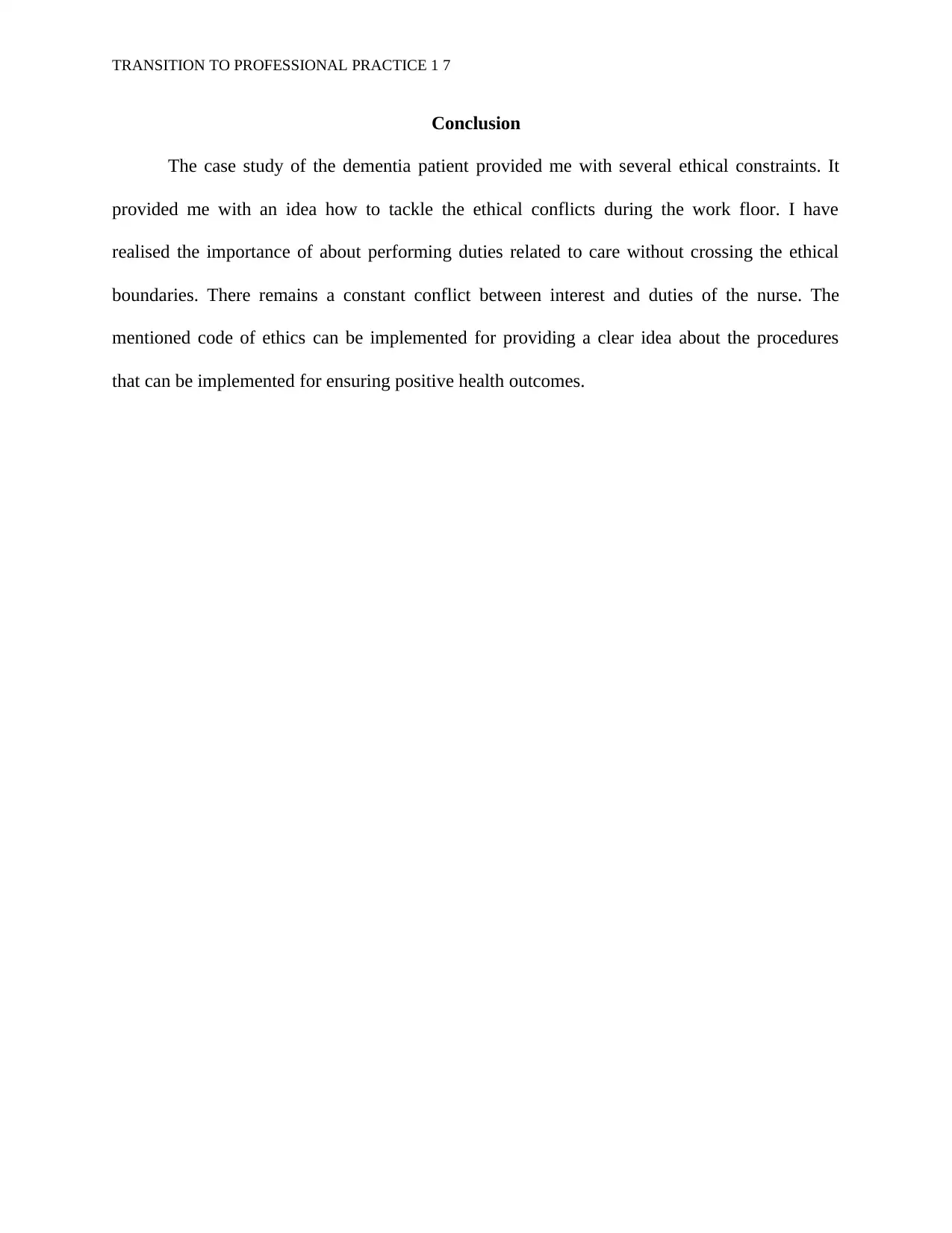
TRANSITION TO PROFESSIONAL PRACTICE 1 7
Conclusion
The case study of the dementia patient provided me with several ethical constraints. It
provided me with an idea how to tackle the ethical conflicts during the work floor. I have
realised the importance of about performing duties related to care without crossing the ethical
boundaries. There remains a constant conflict between interest and duties of the nurse. The
mentioned code of ethics can be implemented for providing a clear idea about the procedures
that can be implemented for ensuring positive health outcomes.
Conclusion
The case study of the dementia patient provided me with several ethical constraints. It
provided me with an idea how to tackle the ethical conflicts during the work floor. I have
realised the importance of about performing duties related to care without crossing the ethical
boundaries. There remains a constant conflict between interest and duties of the nurse. The
mentioned code of ethics can be implemented for providing a clear idea about the procedures
that can be implemented for ensuring positive health outcomes.
Paraphrase This Document
Need a fresh take? Get an instant paraphrase of this document with our AI Paraphraser
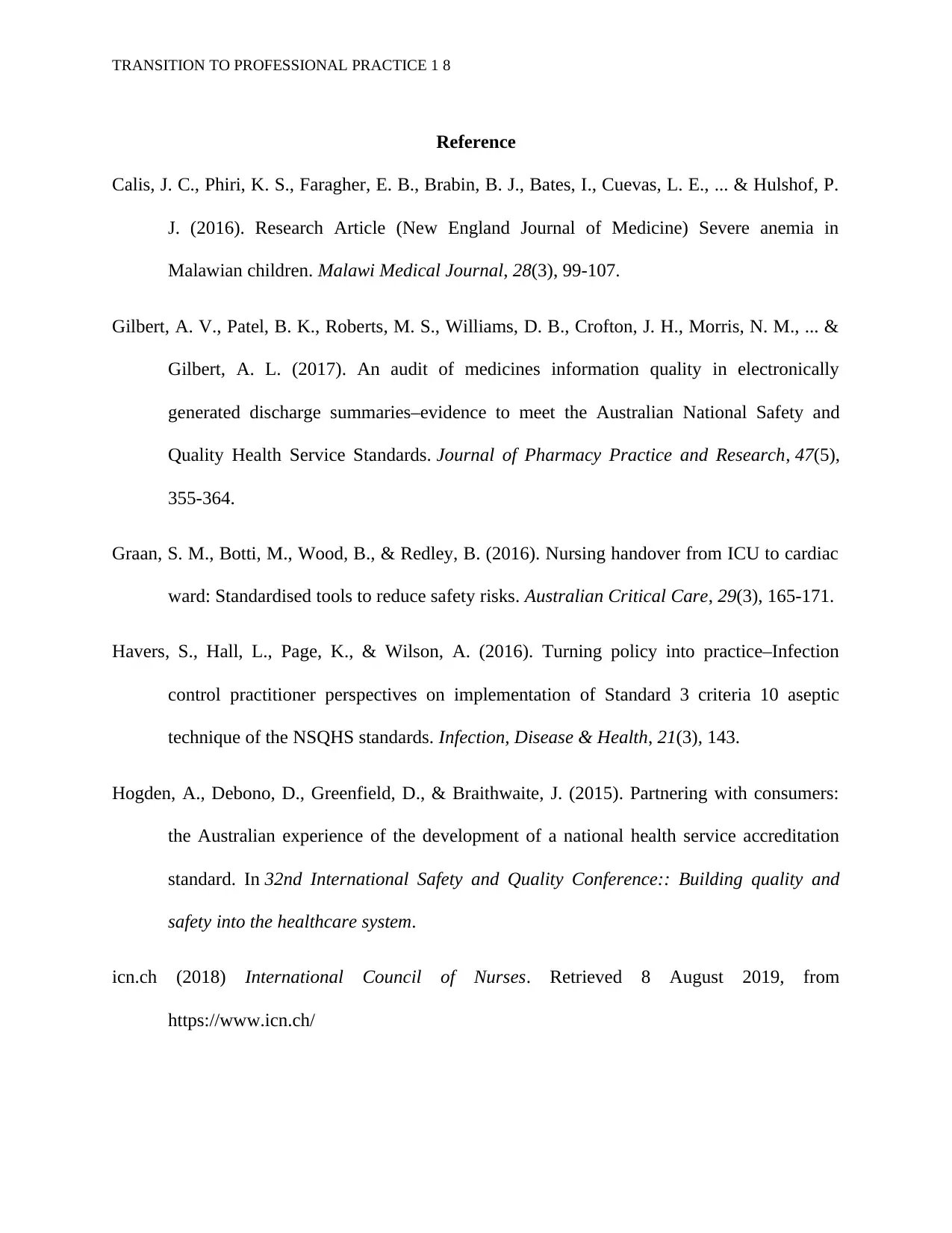
TRANSITION TO PROFESSIONAL PRACTICE 1 8
Reference
Calis, J. C., Phiri, K. S., Faragher, E. B., Brabin, B. J., Bates, I., Cuevas, L. E., ... & Hulshof, P.
J. (2016). Research Article (New England Journal of Medicine) Severe anemia in
Malawian children. Malawi Medical Journal, 28(3), 99-107.
Gilbert, A. V., Patel, B. K., Roberts, M. S., Williams, D. B., Crofton, J. H., Morris, N. M., ... &
Gilbert, A. L. (2017). An audit of medicines information quality in electronically
generated discharge summaries–evidence to meet the Australian National Safety and
Quality Health Service Standards. Journal of Pharmacy Practice and Research, 47(5),
355-364.
Graan, S. M., Botti, M., Wood, B., & Redley, B. (2016). Nursing handover from ICU to cardiac
ward: Standardised tools to reduce safety risks. Australian Critical Care, 29(3), 165-171.
Havers, S., Hall, L., Page, K., & Wilson, A. (2016). Turning policy into practice–Infection
control practitioner perspectives on implementation of Standard 3 criteria 10 aseptic
technique of the NSQHS standards. Infection, Disease & Health, 21(3), 143.
Hogden, A., Debono, D., Greenfield, D., & Braithwaite, J. (2015). Partnering with consumers:
the Australian experience of the development of a national health service accreditation
standard. In 32nd International Safety and Quality Conference:: Building quality and
safety into the healthcare system.
icn.ch (2018) International Council of Nurses. Retrieved 8 August 2019, from
https://www.icn.ch/
Reference
Calis, J. C., Phiri, K. S., Faragher, E. B., Brabin, B. J., Bates, I., Cuevas, L. E., ... & Hulshof, P.
J. (2016). Research Article (New England Journal of Medicine) Severe anemia in
Malawian children. Malawi Medical Journal, 28(3), 99-107.
Gilbert, A. V., Patel, B. K., Roberts, M. S., Williams, D. B., Crofton, J. H., Morris, N. M., ... &
Gilbert, A. L. (2017). An audit of medicines information quality in electronically
generated discharge summaries–evidence to meet the Australian National Safety and
Quality Health Service Standards. Journal of Pharmacy Practice and Research, 47(5),
355-364.
Graan, S. M., Botti, M., Wood, B., & Redley, B. (2016). Nursing handover from ICU to cardiac
ward: Standardised tools to reduce safety risks. Australian Critical Care, 29(3), 165-171.
Havers, S., Hall, L., Page, K., & Wilson, A. (2016). Turning policy into practice–Infection
control practitioner perspectives on implementation of Standard 3 criteria 10 aseptic
technique of the NSQHS standards. Infection, Disease & Health, 21(3), 143.
Hogden, A., Debono, D., Greenfield, D., & Braithwaite, J. (2015). Partnering with consumers:
the Australian experience of the development of a national health service accreditation
standard. In 32nd International Safety and Quality Conference:: Building quality and
safety into the healthcare system.
icn.ch (2018) International Council of Nurses. Retrieved 8 August 2019, from
https://www.icn.ch/
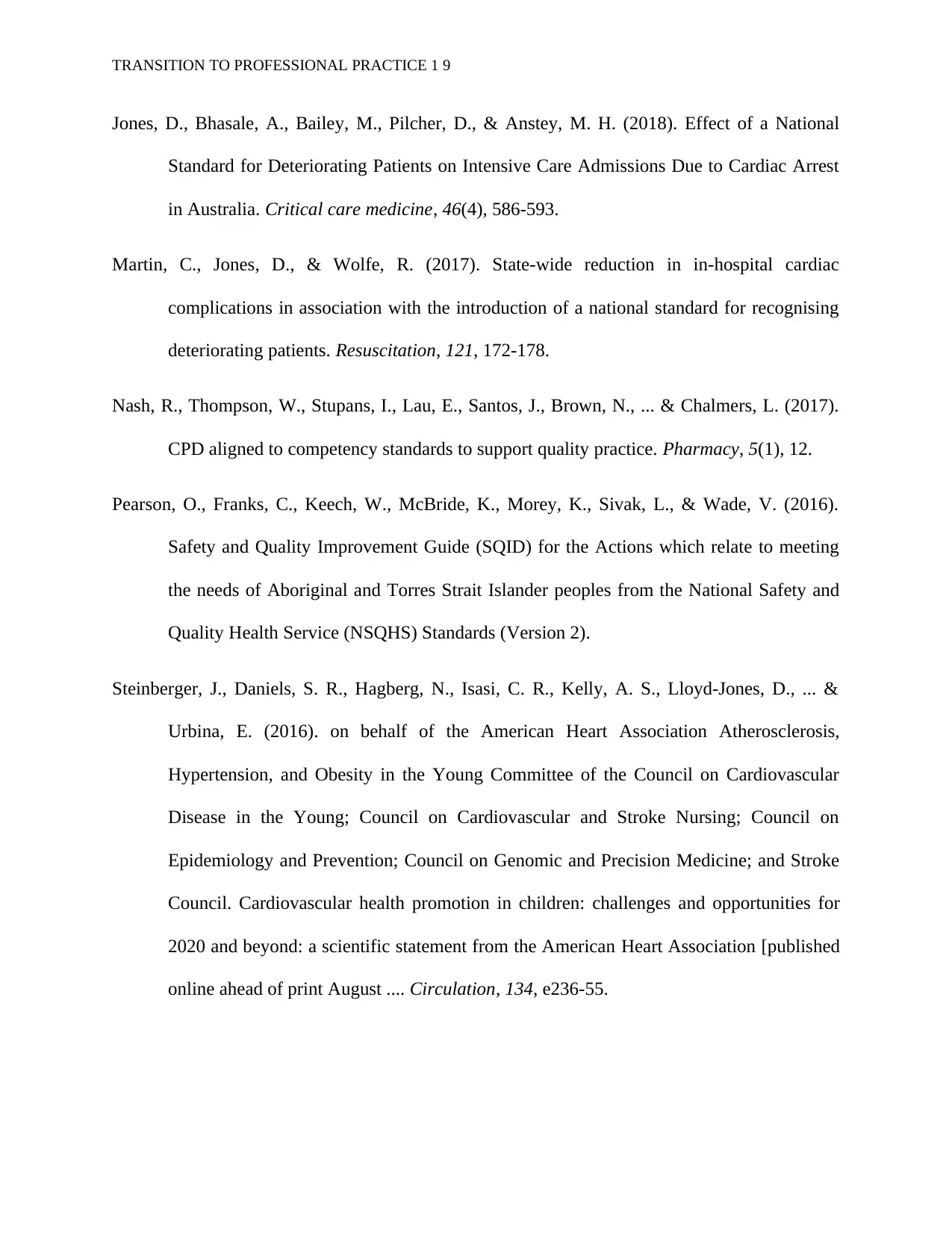
TRANSITION TO PROFESSIONAL PRACTICE 1 9
Jones, D., Bhasale, A., Bailey, M., Pilcher, D., & Anstey, M. H. (2018). Effect of a National
Standard for Deteriorating Patients on Intensive Care Admissions Due to Cardiac Arrest
in Australia. Critical care medicine, 46(4), 586-593.
Martin, C., Jones, D., & Wolfe, R. (2017). State-wide reduction in in-hospital cardiac
complications in association with the introduction of a national standard for recognising
deteriorating patients. Resuscitation, 121, 172-178.
Nash, R., Thompson, W., Stupans, I., Lau, E., Santos, J., Brown, N., ... & Chalmers, L. (2017).
CPD aligned to competency standards to support quality practice. Pharmacy, 5(1), 12.
Pearson, O., Franks, C., Keech, W., McBride, K., Morey, K., Sivak, L., & Wade, V. (2016).
Safety and Quality Improvement Guide (SQID) for the Actions which relate to meeting
the needs of Aboriginal and Torres Strait Islander peoples from the National Safety and
Quality Health Service (NSQHS) Standards (Version 2).
Steinberger, J., Daniels, S. R., Hagberg, N., Isasi, C. R., Kelly, A. S., Lloyd-Jones, D., ... &
Urbina, E. (2016). on behalf of the American Heart Association Atherosclerosis,
Hypertension, and Obesity in the Young Committee of the Council on Cardiovascular
Disease in the Young; Council on Cardiovascular and Stroke Nursing; Council on
Epidemiology and Prevention; Council on Genomic and Precision Medicine; and Stroke
Council. Cardiovascular health promotion in children: challenges and opportunities for
2020 and beyond: a scientific statement from the American Heart Association [published
online ahead of print August .... Circulation, 134, e236-55.
Jones, D., Bhasale, A., Bailey, M., Pilcher, D., & Anstey, M. H. (2018). Effect of a National
Standard for Deteriorating Patients on Intensive Care Admissions Due to Cardiac Arrest
in Australia. Critical care medicine, 46(4), 586-593.
Martin, C., Jones, D., & Wolfe, R. (2017). State-wide reduction in in-hospital cardiac
complications in association with the introduction of a national standard for recognising
deteriorating patients. Resuscitation, 121, 172-178.
Nash, R., Thompson, W., Stupans, I., Lau, E., Santos, J., Brown, N., ... & Chalmers, L. (2017).
CPD aligned to competency standards to support quality practice. Pharmacy, 5(1), 12.
Pearson, O., Franks, C., Keech, W., McBride, K., Morey, K., Sivak, L., & Wade, V. (2016).
Safety and Quality Improvement Guide (SQID) for the Actions which relate to meeting
the needs of Aboriginal and Torres Strait Islander peoples from the National Safety and
Quality Health Service (NSQHS) Standards (Version 2).
Steinberger, J., Daniels, S. R., Hagberg, N., Isasi, C. R., Kelly, A. S., Lloyd-Jones, D., ... &
Urbina, E. (2016). on behalf of the American Heart Association Atherosclerosis,
Hypertension, and Obesity in the Young Committee of the Council on Cardiovascular
Disease in the Young; Council on Cardiovascular and Stroke Nursing; Council on
Epidemiology and Prevention; Council on Genomic and Precision Medicine; and Stroke
Council. Cardiovascular health promotion in children: challenges and opportunities for
2020 and beyond: a scientific statement from the American Heart Association [published
online ahead of print August .... Circulation, 134, e236-55.
⊘ This is a preview!⊘
Do you want full access?
Subscribe today to unlock all pages.

Trusted by 1+ million students worldwide
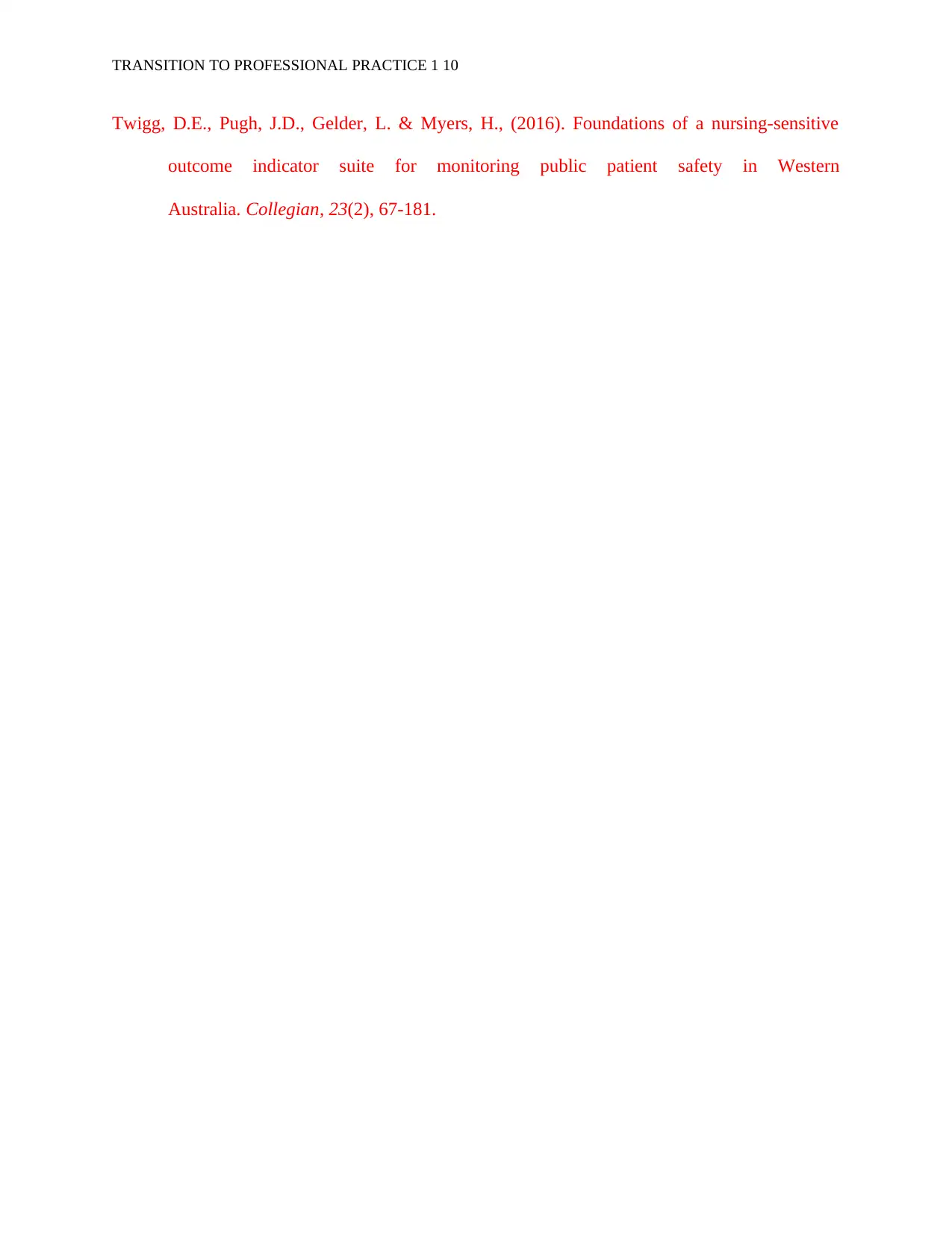
TRANSITION TO PROFESSIONAL PRACTICE 1 10
Twigg, D.E., Pugh, J.D., Gelder, L. & Myers, H., (2016). Foundations of a nursing-sensitive
outcome indicator suite for monitoring public patient safety in Western
Australia. Collegian, 23(2), 67-181.
Twigg, D.E., Pugh, J.D., Gelder, L. & Myers, H., (2016). Foundations of a nursing-sensitive
outcome indicator suite for monitoring public patient safety in Western
Australia. Collegian, 23(2), 67-181.
1 out of 10
Related Documents
Your All-in-One AI-Powered Toolkit for Academic Success.
+13062052269
info@desklib.com
Available 24*7 on WhatsApp / Email
![[object Object]](/_next/static/media/star-bottom.7253800d.svg)
Unlock your academic potential
Copyright © 2020–2025 A2Z Services. All Rights Reserved. Developed and managed by ZUCOL.




